Lighthouse Series- North Carolina
"Tonight wandering sailors pale with fears,
Wide over the watery waste a light appears,
On the far-seen mountain blazing high,
Streams from lonely watchtower to the sky".
(from Homer's Odyssey)
The Outer Banks of North Carolina
I want to give you a brief background about the Outer Banks, which lie off the coast of North Carolina. The Outer Banks is a 200-mile long string of sandy barrier islands about 70 miles from the mainland. The currents that built the islands also tend to push ships too close to them, which has resulted in disaster for at least 2,300 major vessels, giving this area the nickname, “Graveyard of the Atlantic”. You can visit a museum showing artifacts from these shipwrecks at Hatteras, North Carolina. Museum
A 70 mile stretch of the Outer Banks, from Bodie Island to Ocracoke Island, is also known as the Cape Hatteras National Seashore and is managed by the National Park Service. The Outer Banks is an absolutely amazing and beautiful area of my state! If you like lighthouses, I think you should add this to your “bucket list”.
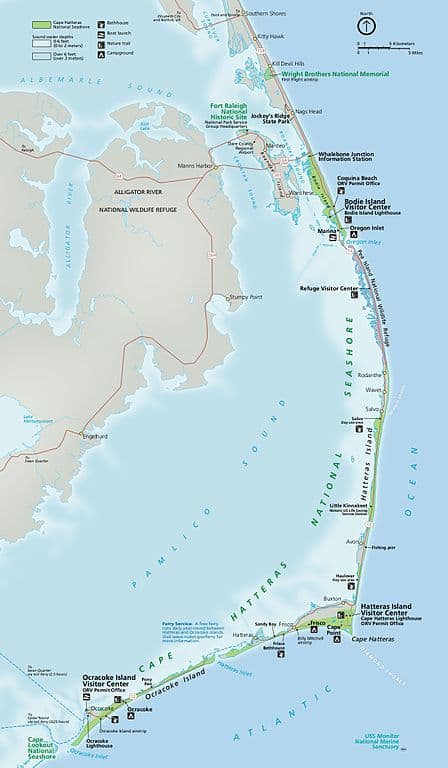
Outer Banks Lighthouses
North Carolina had a total of 23 lighthouses at one time. Many of those lighthouses have been destroyed or demolished. Today there are seven lighthouses still standing, five of which are on the Outer Banks of North Carolina.
- Currituck Beach Light
- Bodie Island Light
- Cape Hatteras Light
- Ocracoke Light
- Cape Lookout Light
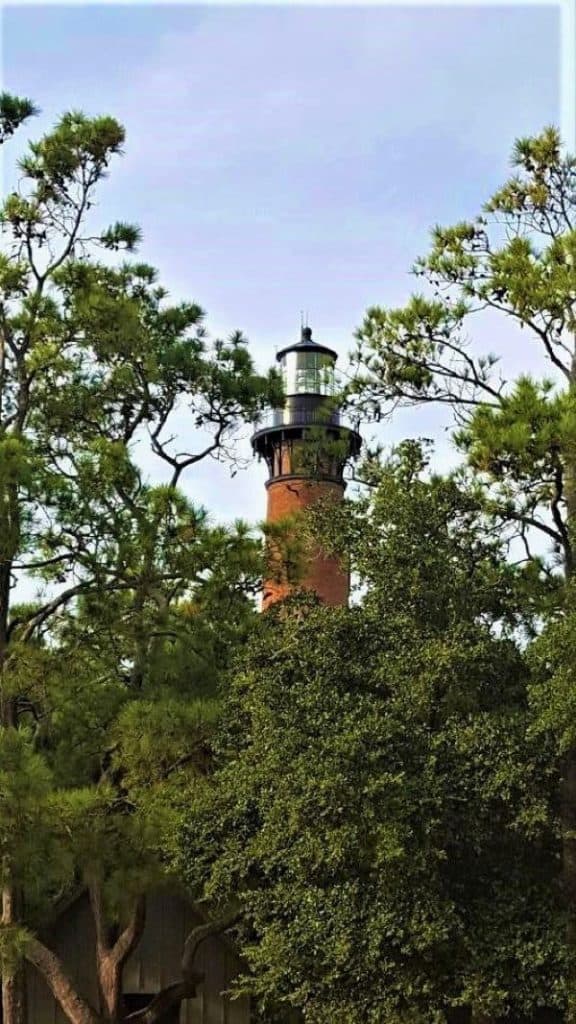
Currituck Beach Light
Note: The Corolla/Currituck Beach is a great area to see one of the last herds of wild horses.
Near the border between North Carolina and Virginia, the Gulf Stream sweeps in close to the mainland. To avoid the strong northeasterly current, Captains must steer close to land, making this a very treacherous area of the Outer Banks. Before 1875, these seamen had no guidance from the shore, it was very difficult to navigate this area, often the beach could not be seen until it was too late. In late 1875, the 162-foot brick tower at Currituck Beach first lit its lamps, at last, illuminating this dangerous stretch of coastline. To withstand the high winds of storms off the Atlantic, they gave it brick walls almost 6 feet thick at the base and 3 feet thick at the top. The red bricks were left unpainted so that mariners could distinguish this tower from others to the North and South. To get to the lighthouse, take state Hwy 12 to the village of Corolla. For a small fee, you can climb the 214 steps to the top, there is also a visitor center and gift shop. It is open Monday-Saturday during the warmer months, April-October. This is also a great area to catch a glimpse of the Outer’s Banks’ last herds of wild horses! Wild horse Adventure Tour
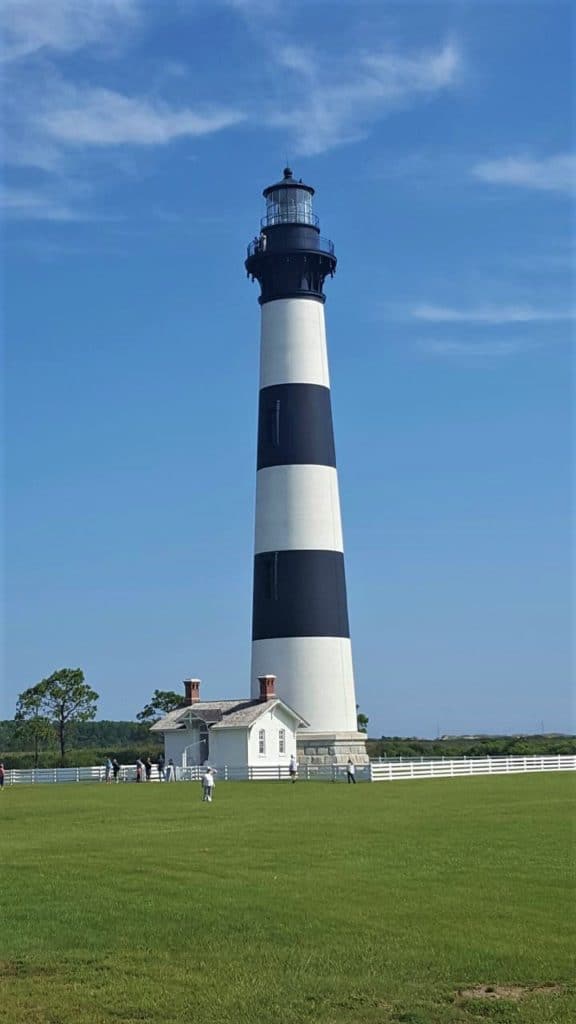
Bodie Island Light
Note: Popular folklore says that the island got its name from the many bodies that washed ashore from shipwrecks.
In 1837 Congress sent Lt. Napoleon Coste to inspect the dark coasts south of the Chesapeake. He found no navigational markers until he reached Cape Hatteras, more than 150 miles to the south. He reported that a lighthouse was urgently needed to fill this huge “blind spot”. They decided the location should be on Bodie Island, close to the northern end of the Outer Banks. The Bodie Island lighthouse has had its share of troubles! The first structure was only 54 feet high, 17 feet in diameter at the base, and 12 feet in diameter at the top. They took shortcuts and did not build it on piles, instead, they built a shallow foundation of brick. Because of this, the tower was unstable and started to lean toward the sea. With each year that passed, it leaned more and more until it had to be destroyed. It was rebuilt in 1859 on sturdy piles and was 80 feet tall! Unfortunately, just over 2 years later in 1861, Confederate troops used explosives to tear it apart! A third tower was built in 1872, it is built on a granite foundation and is even taller, it rises 156 feet above sea level. This Lighthouse is still standing today. It is located on State Hwy 12 and is just south of Nags Head. The lightkeeper’s house is now a visitor center and museum. The tower is climbable with 214 stairs that spiral to the top.
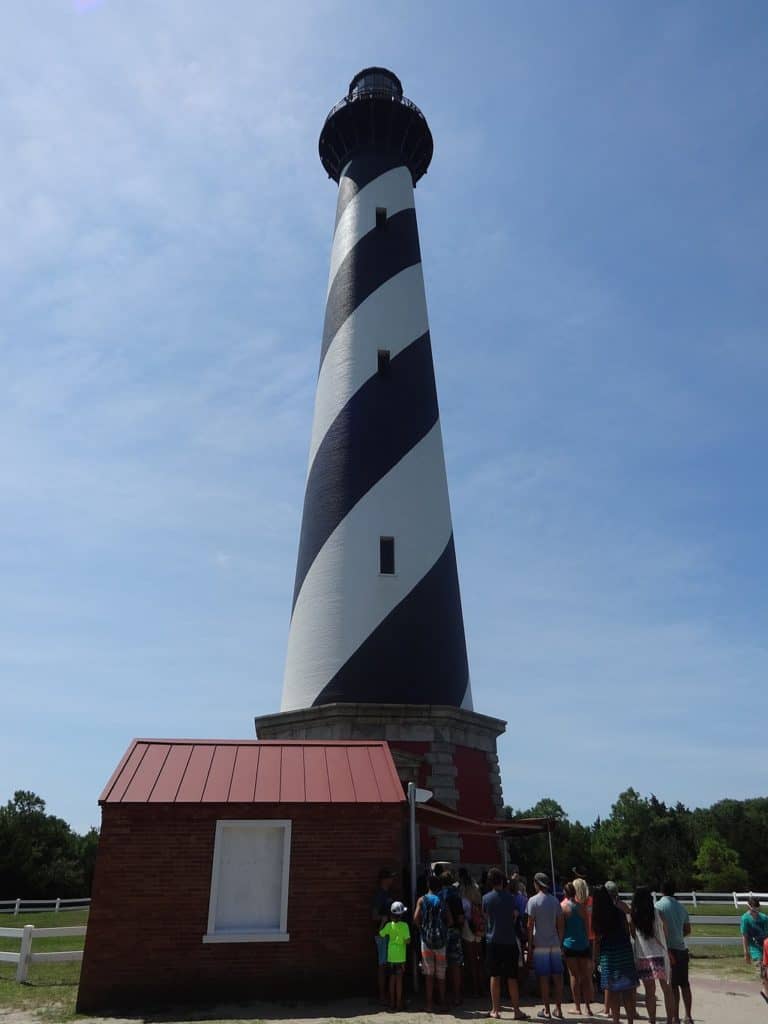
Cape Hatteras Light
Note: This lighthouse had to be moved before it was swallowed up by the Atlantic.
The Lighthouse on Hatteras Island is probably the one most people are familiar with. Two rivers in the ocean collide off the Cape, the cold Labrador current flowing down from the north and the warmer Gulf Stream flowing up from the Caribbean. Their strong currents push ships dangerously close to Hatteras and the Diamond Shoals(a shallow sandbar extending 8 miles out into the ocean). The 95-foot lighthouse was built of sandstone and went into service in 1803, but had a very rocky beginning. Many ship Captains complained that they could not see the light even when nearing the cap. In 1851 U.S. Navy Lieutenant David Porter in a report to the Lighthouse Board called Hatteras “the worst light in the world”. In response to his report and many complaints, the tower was raised to 150 feet in 1854. Unfortunately, during the Civil War, the Confederates destroyed the lighting apparatus. Following the war, the board replaced it with a new, 193-foot brick tower which makes Hatteras the tallest brick lighthouse in the United States!
But, the new Lighthouse was also on its way to certain destruction! Even though it was built almost a quarter-mile from the ocean, the Atlantic’s damaging tides had rolled within a mere hundred feet of the tower’s foundation. The only way to save the lighthouse was to move it, but the idea of relocating a 192 foot tall, 3,500-ton brick tower seemed impossible! The project was undertaken in 1999 and the lighthouse was moved 2900 feet southwest of its previous location.
To reach the lighthouse, take State Hwy 12 and turn off at the village of Buxton, the tower is visible for many miles. The Lighthouse is open during the warmer months, April-October, and you can climb the 257 steps to the top if you dare!
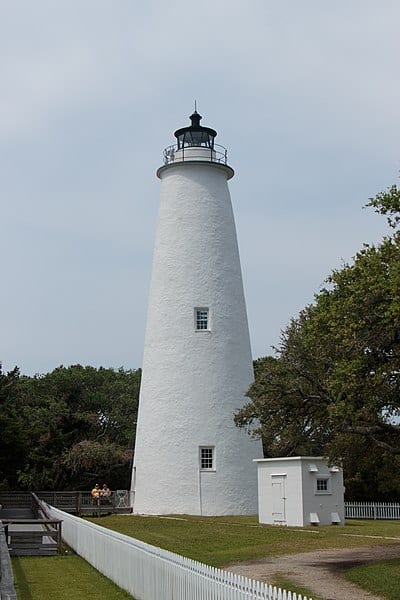
Ocracoke Light
Note: This is where the pirate, Blackbeard had his hideout and may have buried his treasure!
The first Lighthouse on Ocracoke was built in 1803 on Shell Castle Island inside the Ocracoke inlet, not far from Blackbeard’s hideout. Like many of the other lighthouses on the Outer Banks, this lighthouse also had its share of problems. In 1818 it was destroyed by lightning, it was rebuilt in 1823, and is the oldest lighthouse still active on the southern coast. In 1861, Confederate soldiers destroyed the lens, they were replaced in 1864. The lighthouse is 75 feet tall. The unique white color is due to the exterior coating made up of; lime, salt, ground rice, Spanish whiting, and clear glue which was applied to the brick exterior. Ocracoke Island can only be reached by ferry. Visitors can tour the grounds and tower but are not allowed to climb to the top. This lighthouse does not have a visitor center or gift shop but it is still a great place to take photos and check out the lightkeeper’s quarters.
The Legend of Blackbeard
Note: Ocracoke is where Blackbeard, the Pirate, was surrounded by British sailors and killed.
He started life as Edward Teach, born in 1690 to a wealthy British family. He was well educated and handsome, with a thick, black beard. He was hired as a privateer, which is a sailor sanctioned by the British government to rob enemy ships. He fell in love with the pirate lifestyle and after the war, he stole his own vessel and began his own empire. By the time he moved to Ocracoke Island, he had four vessels and over four hundred pirates under his command. He anchored at Ocracoke inlet and plundered merchant ships traveling the shipping lanes off the coast. In 1718 he was cornered by the British Navy and killed, but his legend lives on!
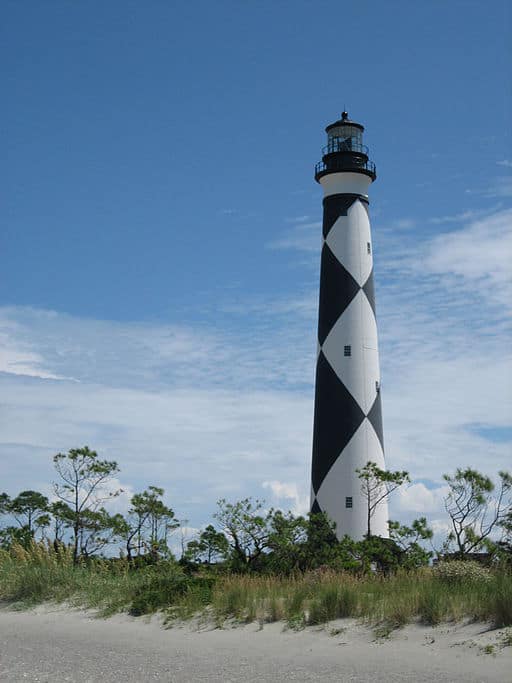
Cape Lookout Light
Note: This was a military stronghold for the Confederate army during the Civil War.
The harbor at Cape Lookout has been a refuge for many. Blackbeard dropped anchor in the harbor, as did the British during the Revolutionary War, and the U.S. Navy during two world wars! The lighthouse at Cape Lookout took many years to build and was finally completed in 1812. It was built of brick and wood, painted with red and white stripes, and stood 104 feet above the water. But, like other lighthouses before it, many captains complained that it could not be seen. A new and improved lighthouse was built in 1859 and stood 156 feet tall. Once again Confederate soldiers knocked out the lens, but they were soon replaced. It was painted the diamond pattern in 1873 to distinguish it from the other lights. The lighthouse is on Core Banks Island and can only be reached by ferry. It is open from May-September and for a small fee you can climb the 207 steps to the top. I have not climbed this lighthouse, but I have no doubt the views at the top are amazing!
I am definitely fascinated with lighthouses! I have not yet climbed to the top of all these lighthouses, but it is on my bucket list! My hope is that I have provided you with information and a desire to see these beautiful lighthouses!
Please leave a comment and share what lighthouses you have seen.
Click HERE to receive our Newsletter with information on other facinating places to visit!
*Featured image: https://www.nps.gov
You may also enjoy these posts:
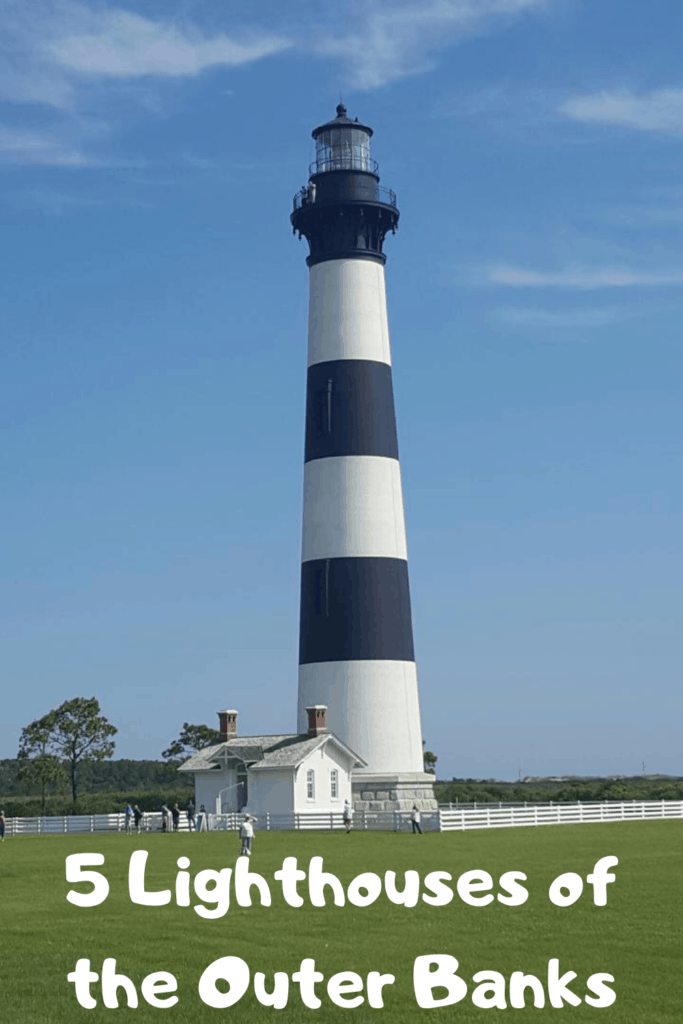

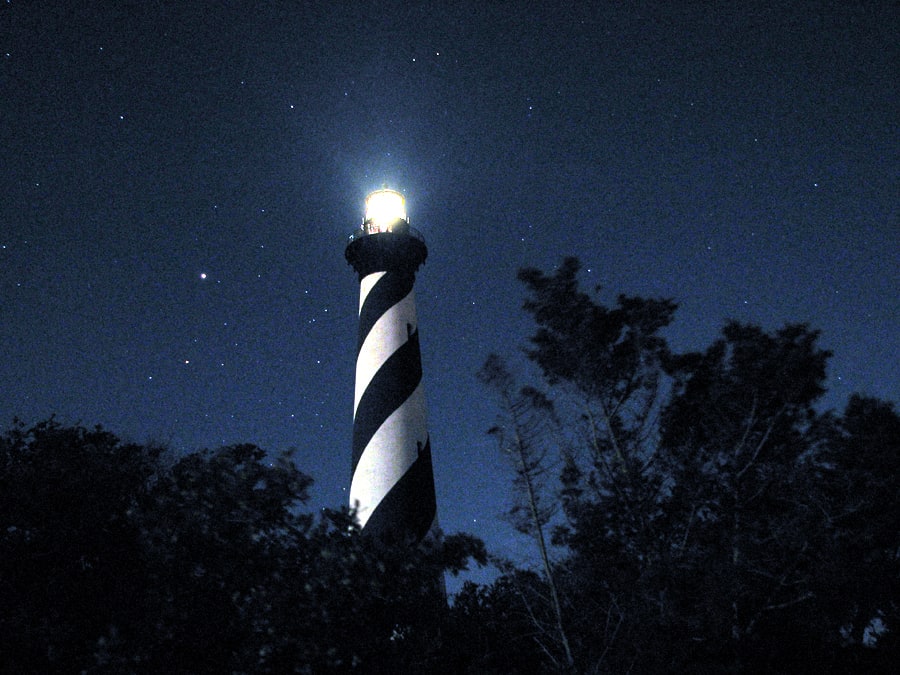
When I lived in S. Carolina, I’ve always wanted to visit the Outer Banks but never get the chance to. Thanks for sharing a bit of history (didn’t know that it has a nickname). The lighthouses are beautiful. Wow that many!
Thanks for reading!
How fun to learn about the legend of Blackbeard! Makes me want to learn more! Thank you for sharing your adventure
I agree! I want to know more about pirates!
Light houses are so cool, and also an often over-looked part of American history.
So True! Thanks for reading!
I think lighthouses are neat. Nice pictures thank you for sharing
Thanks!
Fascinating! I love how beautiful and unique they each are!
Thanks for reading!
Lighthouses are so amazing! I’ve been to a few in Ohio, Michigan, and Maryland but not North Carolina! Thank you for the list, we have great options for when we can travel again.
I love them too! Thanks for reading!
I haven’t been to the Outer Banks in so many years. I really loved our time there, we stayed in Duck, NC. It was such a nice area, I think that some day our family will eventually venture back there, and share this special place with them.
That would be great! Thanks for reading!
When our kids were little we went to Duck every year. Thanks for bringing me back.
It’s a great area!
Your lighthouse tour sounds so fascinating! I’ve seen many in coastal Maine but haven’t made it to North Carolina yet – it’s on our list, though!
I’d love to see the Maine Lighthouses!
This took me back to when I was 12 and went camping for 2 weeks along the shores of Maine. We toured lighthouses & bunkers all along the coast. The Outer Banks is one area I would love to visit!
It’s a beautiful area..thanks for reading!
I love lighthouses! What a great post!
Thanks for reading!
I have family in NC, but haven’t made it to the Outer Banks yet. I do love lighthouses though and had no idea there were so many here. Adding this to my bucket list!
It’s a great Bucket list item! Thanks!
What amazing history! Thank you for sharing!
Thanks for reading!
This seems like such a beautiful area to visit! I would love to go one day
Thanks!
I love the history! I’m not familiar with Outer Banks but it looks like a wonderful place to visit.
It’s a beautiful place!
I’m adding this to my bucket list! I’ve been to North Carolina but not the outer banks, and I do love lighthouses!!
It’s a great bucket list item!
My husband used to live in North Carolina. Always said it is a beautiful place to visit. Although I still have not been there. Thank you for sharing about these lighthouses. I surely must visit to see them with my eyes.
Thanks for reading!
These are beautiful and make me yearn for a beach!
Thanks!
These are gorgeous. I would love to see the outer banks at some point.
Thanks!
I like the different patterns on the lighthouses
Yep, each one is unique!
I would love to see these – I just hate driving on bridges! Yikes! Might be worth it one day!
I am with you! I hate bridges too!
I have to visit these. I am definitely saving this for when I get there. Thanks!
Awesome! Thanks for reading!
My parents (especially mom!) loves lighthouses and “collected” them for years as they checked them off of their Bucket List. Some of them are so imposing and impressive while others are functional and quaint. A great way to create a “scavenger hunt” of sorts for some great road trips and memories!
Cool! Thanks for reading!
I love seeing lighthouses! The outerbanks sounds like a great vacation.
Thanks!
Very interesting – I would love to visit here one day! Loved the story of Blackbeard the pirate.
I love Blackbeard too! Thanks for reading!
What a cool vacation and beautiful images. It made me feel like I was there visiting too!
Thanks so much!
Would love to check it out! Nice pics!
Thanks!
The Outer Banks has been on my bucket list for so long! I definitely want to visit these lighthouses and see the wild horses too!
It would be a great vacation!
My dad loves lighthouses and has several of the books you recommend.
Awesome!
I have such fond memories of this area! My grandparents retired to Harker’s Island and I loved our visits. That island has gotten a lot more built up in recent years, but I remember helping my grandfather pull in the fishing nets in the sound at daybreak.
Wow! What great memories you must have!
I lived in North Carolina for seven years but never made it to the Outer Banks. I very much regret that. I would love to take a road trip to visit all the lighthouses.
Maybe you still can some day!
what a great listing of a unique American bit of history and landmark! Thank you ! book marking!
Thanks!